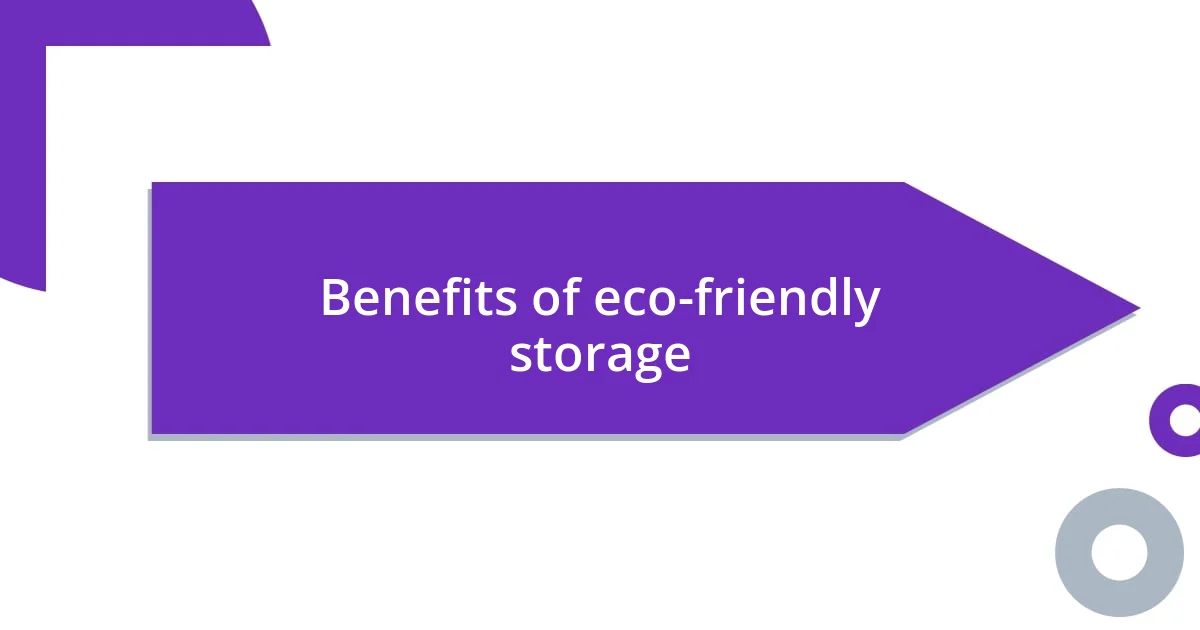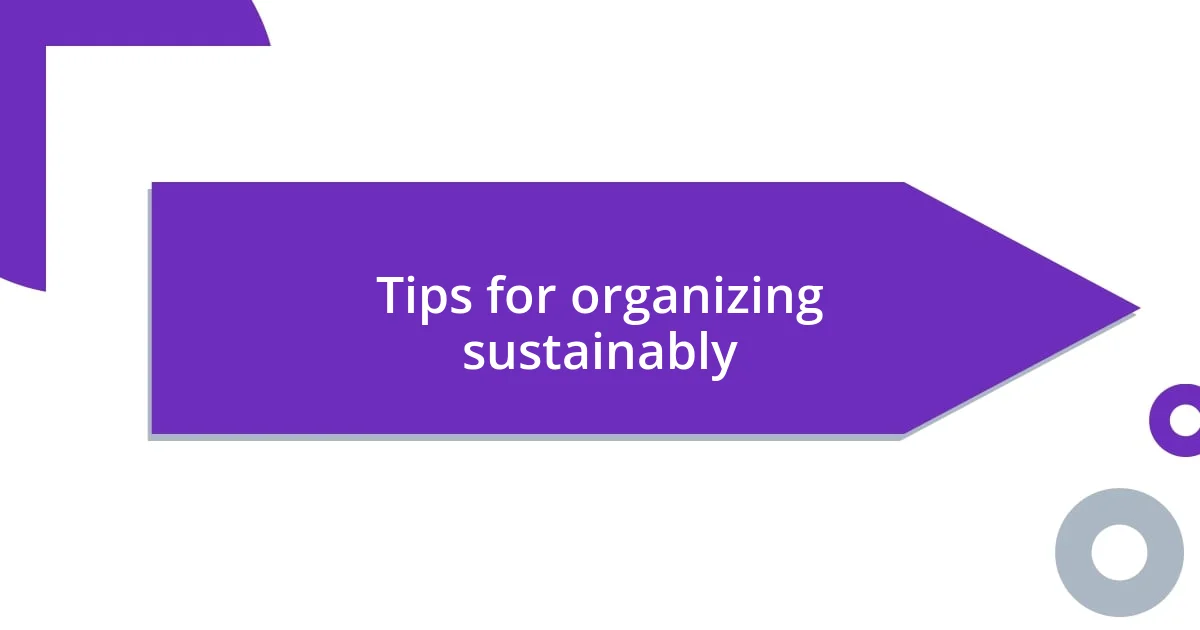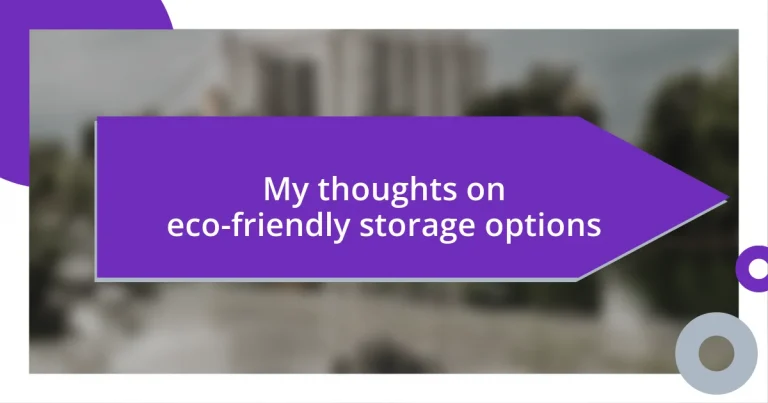Key takeaways:
- Eco-friendly storage options, such as upcycled furniture and natural materials, minimize waste and add unique character to spaces.
- Using sustainable materials leads to a healthier living environment and can positively impact overall well-being and mood.
- Investing in durable, eco-friendly storage solutions may have higher upfront costs but provides long-term value, reducing the need for frequent replacements.

Understanding eco-friendly storage options
When I first started exploring eco-friendly storage options, I was genuinely surprised by the variety available. From biodegradable materials to sustainable wood products, it opened my eyes to how our choices can significantly impact the environment. Thinking about it, have you ever wondered how many plastic bins end up in landfills every year?
One option that’s really caught my attention is upcycled furniture. I once transformed an old wooden crate into a stylish bookshelf, and not only did it look fantastic, but it also had a story behind it. This kind of creative reuse not only minimizes waste but also gives a unique character to your home. Have you considered how much personality you could add to your space with simple eco-friendly choices?
It’s fascinating to realize that even small changes in our storage solutions can lead to a more sustainable lifestyle. The buzz about natural materials like bamboo or cork resonates deeply with me; they’re not just attractive but also renewable. I often reflect on how such choices empower me to contribute to a healthier planet, one thoughtful decision at a time. What eco-friendly storage solution would spark joy for you?

Benefits of eco-friendly storage
When I think about the benefits of eco-friendly storage, the advantages stretch far beyond just reducing waste. One of my favorite aspects is the positive impact on my overall well-being. I remember rearranging my storage by opting for natural materials, which made my space feel warm and inviting. It was more than just aesthetics; it genuinely uplifted my mood every time I entered the room, reminding me that my choices could bring joy while being kind to the planet.
Here are some key benefits of eco-friendly storage:
- Reduction of Waste: Utilizing sustainable materials means fewer items in landfills.
- Healthier Living Environment: Natural materials are often free from harmful chemicals found in plastics.
- Unique Aesthetic: Eco-friendly storage options can add character to your home, showcasing your values and creativity.
- Cost-effectiveness: Many upcycled or sustainable products can be more affordable long-term due to their durability.
- Community Impact: Supporting local artisans and businesses that prioritize sustainability fosters a sense of community around shared values.

Materials for sustainable storage solutions
When it comes to materials for sustainable storage solutions, my experience has shown me the true beauty of natural fibers. I’ve found that cotton and jute are not only durable but also biodegradable. There was a time when I purchased woven jute baskets for organizing my magazines. Their earthy vibe brought an instant warmth to my living room while allowing me to keep clutter at bay. Have you ever considered how a simple change in material can transform the feel of a space?
Another standout for me has been bamboo. It’s astonishingly strong and incredibly lightweight, which makes it perfect for various storage options. I used bamboo storage boxes in my kitchen and noticed how seamlessly they blend with my decor. Plus, knowing that bamboo is a fast-growing plant made me feel good about my choice. Isn’t it rewarding to incorporate such versatile materials into our daily lives?
Lastly, I can’t overlook the appeal of recycled plastic, especially for those seeking practical, eco-friendly solutions. I once came across storage bins made entirely from recycled bottles. They were surprisingly sturdy and perfect for outdoor organization. I was impressed by how they lessen the need for new plastics while serving a functional purpose. It’s intriguing to think about how materials that have lived another life can now be part of our homes, isn’t it?
| Material | Benefits |
|---|---|
| Cotton | Biodegradable; offers a soft feel; versatile for various applications |
| Jute | Durable; adds a natural aesthetic; great for baskets |
| Bamboo | Lightweight; fast-growing; renewable resource |
| Recycled Plastic | Repurposes waste; strong; often more affordable |

Innovative designs for eco-friendly storage
There’s something incredibly exciting about innovative designs in eco-friendly storage options. I remember stumbling upon modular shelving made from reclaimed wood. Not only did it provide a sleek, contemporary look, but it also sparked conversations about sustainability each time guests visited. I love how these designs encourage a unique message: that style and eco-consciousness can beautifully coexist. Have you ever found that perfect piece that just speaks to you and your values?
One of my recent favorites is furniture that serves multiple purposes, like storage ottomans crafted from recycled materials. These cleverly designed pieces add a cozy touch to my living room while offering hidden space for organizing blankets and books. It’s amazing how a simple item can declutter a room while also serving as an attractive focal point. Isn’t it refreshing to think about functionality merging with creativity in our living spaces?
I’m also captivated by the rise of DIY eco-friendly storage solutions. The last project I tackled involved repurposing old wooden crates into charming storage for my crafting supplies. It brought me joy to rediscover those crates from the garage, transforming them into something useful rather than letting them collect dust. This hands-on approach not only minimized waste but allowed me to infuse my personal style into every corner of my home. Have you tried your hand at a DIY project? It’s empowering to witness what you can create with a little imagination!

Tips for organizing sustainably
One of the simplest yet most effective tips I’ve discovered for organizing sustainably is to embrace a decluttering mindset. I remember the moment I donated a whole box of unused items. It felt liberating to let go of things I no longer needed while knowing I was giving them a chance at a new life. Have you ever felt that weight lift off your shoulders when you declutter? It’s not just about creating space; it’s about transforming your relationship with your belongings.
Layering is another powerful organizing technique I’ve come to love. By using stacking bins made from eco-friendly materials, I can maximize vertical space in my storage areas. For example, I transformed a small corner of my laundry room with a set of bamboo bins, neatly stacked for easy access to supplies. The visual appeal of organized layers makes the space feel more inviting and functional. Isn’t it wonderful how a little creativity can breathe new life into even the smallest spaces?
Lastly, I can’t stress enough the importance of choosing multipurpose storage solutions. I found a charming wooden trunk that not only serves as a coffee table but also hides away games and blankets. This piece makes my living room cozier and encourages family gatherings, all while keeping clutter at bay. It’s like a two-for-one deal, wouldn’t you agree? By thoughtfully selecting items that fulfill more than one function, we not only save space but also invest in pieces that enrich our lives.

Comparing cost and value
When I compare the cost and value of eco-friendly storage options, I find it fascinating how initial prices can sometimes mislead us. For instance, I once splurged on a set of baskets made from sustainably harvested materials. Yes, they were pricier upfront, but their durability and aesthetic charm turned out to be a sound investment. Have you noticed how some items just elevate the space and pervade a sense of purpose in your home?
I’ve also discovered that the longevity of these solutions often far outweighs their initial cost. A beautiful reclaimed wood shelving unit I purchased years ago has withstood the test of time, while cheaper alternatives have needed frequent replacements. This has made me reflect on what “value” truly means. Is it just about the price tag, or is it more about how an item enhances our daily lives?
Another aspect I consider is the environmental impact, which can translate into long-term savings. I once had a conversation about the hidden costs of fast furniture—things like shipping carbon footprints and the need to dispose of items that break after a few uses. When I opt for eco-friendly storage solutions, I feel I’m contributing positively, which is immensely satisfying. Haven’t you felt more at ease knowing your purchases align with your values?












